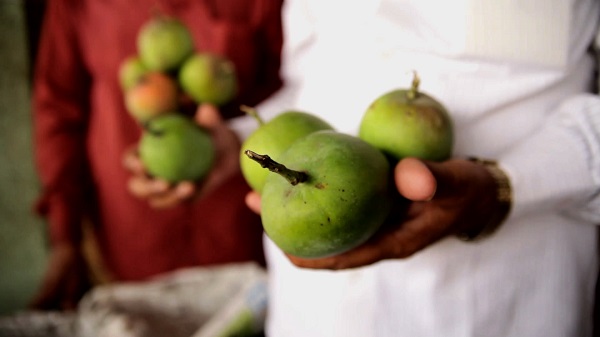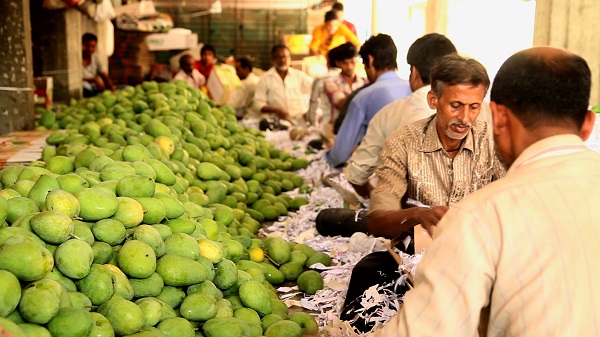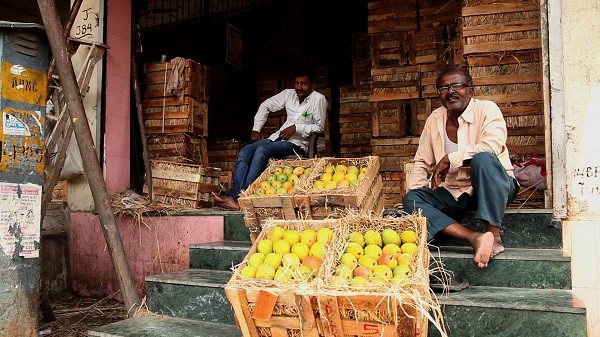
Alphonsos have arrived in the market. But the eyebrow raising price-tag means that Maharashtra’s Hapus is available to only those with big wallets or Euros.
Majestic Restaurant, a popular watering hole for middle-income tourists visiting Mumbai’s Colaba has brought its season special back – the Alphonso mango shake is on the menu again. But before you rush to order it be warned, it’s 30% more expensive than it was last year. The glass now costs Rs.80.
A few kilometers away, fruit retailers in Breach Candy, who are patronized by Mumbai’s rich and powerful are selling Ratnagiri Alphonsos for Rs.1200/- a dozen. This tear-inducing price tag is due to the lack of supply from the coastal region of Maharashtra, where untimely rains in December – January damaged crops during the flowering stage itself.
The prices are reflective of the supply shortage. However, I believe that the consumer actually benefits when prices are high because quality is assured. If you buy one crate, the chances of even one mango turning out bad are very less.
A walk down Maharashtra’s biggest agricultural produce market in Navi Mumbai, the APMC (Agricultural Produce Market Committee) Market in the morning hours saw mango traders sitting and sipping tea—an unusual sight for sure. In normal years, morning peak business hours generally see up to 500 fruit trucks queuing up and loaders bustling about to unload crates full of mangoes. This year the daily average is about 80 trucks bearing around 50,000 crates of mangoes as compared to last year’s daily average of 200 trucks.
A chat with Ravindranath Khot, a farmer from Ratnagiri, who was in APMC to meet with wholesale traders, reveals that the shortage is so acute that orchards which have consistently produced 400 crates every year have barely managed 40 crates this season. Hence, prime quality or export grade Alphonsos are being sold at Rs. 3200/- for five dozens or a crateful at the wholesale market. Last year the same grade of mangoes were being sold at Rs.1800/- a crate. Amit Vasandani, a seventh generation wholesale trader says, “The prices are reflective of the supply shortage. However, I believe that the consumer actually benefits when prices are high because quality is assured. If you buy one crate, the chances of even one mango turning out bad are very less.”
 Workers sort mangoes for export at the APMC Market, Navi Mumbai
Workers sort mangoes for export at the APMC Market, Navi Mumbai
Last year's EU ban had meant a windfall for local consumers, who saw good-quality Alphonsos for as low as about Rs. 350/- per dozen. But this year, the shortfall in supply combined with a resumption in exports (as the European countries receive 10-12% of the total produce) means that prices will remain high for most of the season.
The shortage is also compounded by the fact that the European Union, which had banned Indian Alphonsos last year, has lifted the ban. The EU had banned the import of all Indian mangoes after a few consignments were found infected with fruit flies—a native of India but considered deadly for European greens. The Indian government worked hard to put in place a standardized ripening and packaging process, which was inspected by the EU authorities earlier this year and the ban was lifted in January 2015.
Last year's EU ban had meant a windfall for local consumers, who saw good-quality Alphonsos for as low as about Rs. 350/- per dozen. But this year, the shortfall in supply combined with a resumption in exports (as the European countries receive 10-12% of the total produce) means that prices will remain high for most of the season. But even as consumers feel the brunt, the lifting of the ban does spell good cheer for wholesale traders like L. Khanvilkar, whose family has been in this business since 1946, “It was a sad sight last year as boxes would remain lying around with no takers as production was good but there was a ban. The losses of last year will not be completely written off as I have so few mangoes coming in.”
Wholesalers believe that there is another reason for the price rise, and that is, a change in consumption habits. Traditionally, the Maharashtrian festival of Gudi Padwa heralded the start of the mango season. But, an increase in the purchasing power and consumer awareness means the traditional mango season has almost doubled, starting from Mid-March and lasting up to the end of June. Traders who would earlier have farmers just from Maharashtra as suppliers, now have mangoes coming in from Karnataka too. Vasandani explains, “Only the wholesale trader knows which region the mango has come from because there is no way in which you can physically differentiate an Alphonso from Maharashtra or one from Karnataka. However, I have patrons who have been buying from me for generations and we ensure that we disclose the origins as it’s a matter of trust and goodwill.”
 Dadar market: Alphonso mango traders sit idle
Dadar market: Alphonso mango traders sit idle
Even as many will perhaps satiate their mango fetish with other varieties such as the Langda from UP or Kesar from Gujarat, hardcore Alphonso lovers say that they are willing to spring the extra for a bite of Maharashtra’s pride - the Alphonso. They do, however, agree that the jump from last year’s Rs. 150 a kilo to this year’s Rs. 350/ kilo makes it a fruit not everyone can afford.